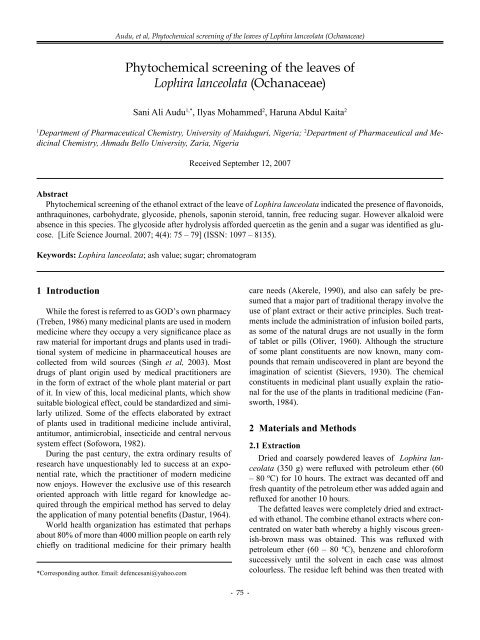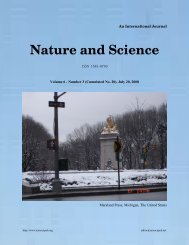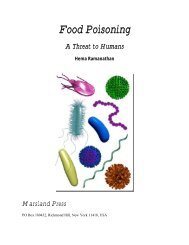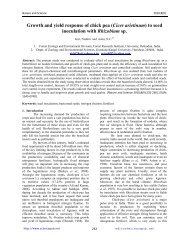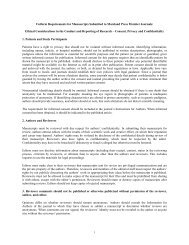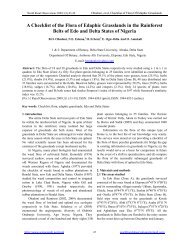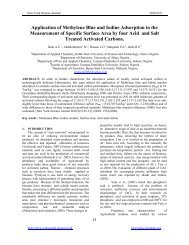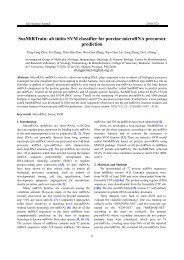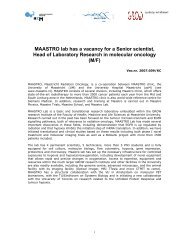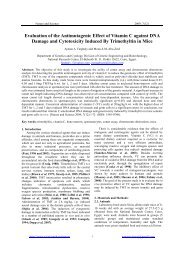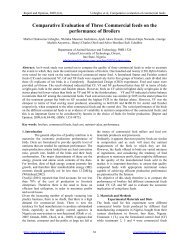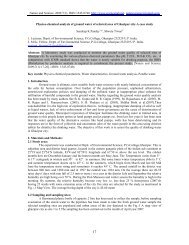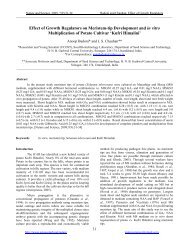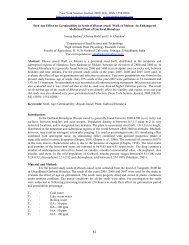Phytochemical screening of the leaves of Lophira lanceolata ...
Phytochemical screening of the leaves of Lophira lanceolata ...
Phytochemical screening of the leaves of Lophira lanceolata ...
Create successful ePaper yourself
Turn your PDF publications into a flip-book with our unique Google optimized e-Paper software.
Audu, et al, <strong>Phytochemical</strong> <strong>screening</strong> <strong>of</strong> <strong>the</strong> <strong>leaves</strong> <strong>of</strong> <strong>Lophira</strong> <strong>lanceolata</strong> (Ochanaceae)<br />
<strong>Phytochemical</strong> <strong>screening</strong> <strong>of</strong> <strong>the</strong> <strong>leaves</strong> <strong>of</strong><br />
<strong>Lophira</strong> <strong>lanceolata</strong> (Ochanaceae)<br />
Sani Ali Audu 1,* , Ilyas Mohammed 2 , Haruna Abdul Kaita 2<br />
1<br />
Department <strong>of</strong> Pharmaceutical Chemistry, University <strong>of</strong> Maiduguri, Nigeria; 2 Department <strong>of</strong> Pharmaceutical and Medicinal<br />
Chemistry, Ahmadu Bello University, Zaria, Nigeria<br />
Received September 12, 2007<br />
Abstract<br />
<strong>Phytochemical</strong> <strong>screening</strong> <strong>of</strong> <strong>the</strong> ethanol extract <strong>of</strong> <strong>the</strong> leave <strong>of</strong> <strong>Lophira</strong> <strong>lanceolata</strong> indicated <strong>the</strong> presence <strong>of</strong> flavonoids,<br />
anthraquinones, carbohydrate, glycoside, phenols, saponin steroid, tannin, free reducing sugar. However alkaloid were<br />
absence in this species. The glycoside after hydrolysis afforded quercetin as <strong>the</strong> genin and a sugar was identified as glucose.<br />
[Life Science Journal. 2007; 4(4): 75 – 79] (ISSN: 1097 – 8135).<br />
Keywords: <strong>Lophira</strong> <strong>lanceolata</strong>; ash value; sugar; chromatogram<br />
1 Introduction<br />
While <strong>the</strong> forest is referred to as GOD’s own pharmacy<br />
(Treben, 1986) many medicinal plants are used in modern<br />
medicine where <strong>the</strong>y occupy a very significance place as<br />
raw material for important drugs and plants used in traditional<br />
system <strong>of</strong> medicine in pharmaceutical houses are<br />
collected from wild sources (singh et al, 2003). Most<br />
drugs <strong>of</strong> plant origin used by medical practitioners are<br />
in <strong>the</strong> form <strong>of</strong> extract <strong>of</strong> <strong>the</strong> whole plant material or part<br />
<strong>of</strong> it. In view <strong>of</strong> this, local medicinal plants, which show<br />
suitable biological effect, could be standardized and similarly<br />
utilized. Some <strong>of</strong> <strong>the</strong> effects elaborated by extract<br />
<strong>of</strong> plants used in traditional medicine include antiviral,<br />
antitumor, antimicrobial, insecticide and central nervous<br />
system effect (S<strong>of</strong>owora, 1982).<br />
During <strong>the</strong> past century, <strong>the</strong> extra ordinary results <strong>of</strong><br />
research have unquestionably led to success at an exponential<br />
rate, which <strong>the</strong> practitioner <strong>of</strong> modern medicine<br />
now enjoys. However <strong>the</strong> exclusive use <strong>of</strong> this research<br />
oriented approach with little regard for knowledge acquired<br />
through <strong>the</strong> empirical method has served to delay<br />
<strong>the</strong> application <strong>of</strong> many potential benefits (Dastur, 1964).<br />
World health organization has estimated that perhaps<br />
about 80% <strong>of</strong> more than 4000 million people on earth rely<br />
chiefly on traditional medicine for <strong>the</strong>ir primary health<br />
*Corresponding author. Email: defencesani@yahoo.com<br />
care needs (Akerele, 1990), and also can safely be presumed<br />
that a major part <strong>of</strong> traditional <strong>the</strong>rapy involve <strong>the</strong><br />
use <strong>of</strong> plant extract or <strong>the</strong>ir active principles. Such treatments<br />
include <strong>the</strong> administration <strong>of</strong> infusion boiled parts,<br />
as some <strong>of</strong> <strong>the</strong> natural drugs are not usually in <strong>the</strong> form<br />
<strong>of</strong> tablet or pills (Oliver, 1960). Although <strong>the</strong> structure<br />
<strong>of</strong> some plant constituents are now known, many compounds<br />
that remain undiscovered in plant are beyond <strong>the</strong><br />
imagination <strong>of</strong> scientist (Sievers, 1930). The chemical<br />
constituents in medicinal plant usually explain <strong>the</strong> rational<br />
for <strong>the</strong> use <strong>of</strong> <strong>the</strong> plants in traditional medicine (Fansworth,<br />
1984).<br />
2 Materials and Methods<br />
2.1 Extraction<br />
Dried and coarsely powdered <strong>leaves</strong> <strong>of</strong> <strong>Lophira</strong> <strong>lanceolata</strong><br />
(350 g) were refluxed with petroleum e<strong>the</strong>r (60<br />
– 80 ºC) for 10 hours. The extract was decanted <strong>of</strong>f and<br />
fresh quantity <strong>of</strong> <strong>the</strong> petroleum e<strong>the</strong>r was added again and<br />
refluxed for ano<strong>the</strong>r 10 hours.<br />
The defatted <strong>leaves</strong> were completely dried and extracted<br />
with ethanol. The combine ethanol extracts where concentrated<br />
on water bath whereby a highly viscous greenish-brown<br />
mass was obtained. This was refluxed with<br />
petroleum e<strong>the</strong>r (60 – 80 ºC), benzene and chlor<strong>of</strong>orm<br />
successively until <strong>the</strong> solvent in each case was almost<br />
colourless. The residue left behind was <strong>the</strong>n treated with<br />
∙ 75 ∙
Life Science Journal, Vol 4, No 4, 2007<br />
http://lsj.zzu.edu.cn<br />
hot water. The water insoluble portion was dissolved in<br />
ethanol and dried under reduced pressure. A solid brown<br />
residue (30.2 g) obtained respond to usual flavonoid colour<br />
tests was marked “A”.<br />
The aqueous solution was extracted with ethyl acetate.<br />
The process was repeated twice. The ethyl acetate extract<br />
where combined and <strong>the</strong> solvent was recovered under reduced<br />
pressure. The semi- solid residue was marked “A 1 ”<br />
and respond to usual flavonoidal test.<br />
2.2 Thin layer chromatographic examination <strong>of</strong> fraction<br />
“A”<br />
Thin layer chromatographic plate (5 × 20 cm) 0.5 mm<br />
thickness was prepared by usual method using silica gel<br />
G (E.Merck). The sample <strong>of</strong> 0.1% <strong>of</strong> “A” was dissolve in<br />
alcohol and spotted manually using a capillary tube. The<br />
plate was developed in BPF (benzene : pyridine : formic<br />
acid, 36 : 9 : 5) as solvent system. After development, on<br />
examination <strong>of</strong> <strong>the</strong> chromatogram under U.V. light and<br />
<strong>the</strong>n sprayed with ferric chloride <strong>the</strong> presence <strong>of</strong> one spot<br />
with trailing was revealed. This was purified with column<br />
chromatography.<br />
2.3 Fraction “A 1 ”<br />
The ethanol solution <strong>of</strong> fraction “A 1 ” was subjected to<br />
paper chromatographic analysis using Whatmann paper<br />
No.1. In each solvent system, <strong>the</strong> chromatograms were<br />
developed for 10 hours. After drying in fume cupboard,<br />
<strong>the</strong> chromatograms were examined under U.V. light,<br />
which revealed <strong>the</strong> presence <strong>of</strong> two spots with trailing.<br />
2.4 Hydrolysis <strong>of</strong> fraction “A 1 ”<br />
10 mg <strong>of</strong> fraction “A 1 ” was dissolved in water and hydrolyzed<br />
by refluxing with 2 ml <strong>of</strong> 0.6 M hydrochloric<br />
acid. The hydrolysis appeared to be completed within a<br />
few munites, but <strong>the</strong> heating was continued for 2 hours to<br />
ensure complete hydrolysis. After leaving over-night, <strong>the</strong><br />
aglycone was filtered, washed, dried at room temperature<br />
and marked fraction G.<br />
2.5 Chromatographic identification <strong>of</strong> <strong>the</strong> sugar<br />
The filtrate (from which <strong>the</strong> aglycone was removed)<br />
was neutralized with aqueous ammonia until it was neutral<br />
to litmus paper. It was concentrated under reduced<br />
pressure to a syrupy mass. This syrupy mass was chromatographed<br />
on whatmann paper No. 1 using n-Butanol<br />
: acetic acid : water (4 : 1 : 5) as solvent system with<br />
au<strong>the</strong>ntic (reference sugar) samples. The chromatogram<br />
after development was dried in a fume cupboard sprayed<br />
with aniline-H-phthalate reagent and <strong>the</strong>n heated at 110ºC<br />
for 5 minutes. After development on examination <strong>the</strong><br />
chromatogram shows <strong>the</strong> presence <strong>of</strong> a spots equivalent<br />
to R f values <strong>of</strong> au<strong>the</strong>ntic glucose were revealed.<br />
2.6 Preparation <strong>of</strong> au<strong>the</strong>ntic sugar<br />
The au<strong>the</strong>ntic sugar rhamnose, glucose, galactose,<br />
fructose, xylose and arabinose were prepared by dissolving<br />
small sample <strong>of</strong> <strong>the</strong> sugar in distilled water.<br />
2.7 Quantitative evaluation <strong>of</strong> <strong>the</strong> leave <strong>of</strong> <strong>Lophira</strong> <strong>lanceolata</strong><br />
<strong>leaves</strong>.<br />
(a) Determination <strong>of</strong> total ash value<br />
(b) Determination <strong>of</strong> acid insoluble ash value<br />
(c) Determination <strong>of</strong> water-soluble ash value<br />
(d) Alcohol soluble extractive value<br />
(e) Water soluble extractive value (British Pharmacopoeia,<br />
1993).<br />
3 Results<br />
On defatting <strong>the</strong> powdered leave <strong>of</strong> <strong>the</strong> plant material<br />
with petroleum e<strong>the</strong>r (60 – 80 ºC), <strong>the</strong> merc was extracted<br />
with ethanol. The ethanol extract was fractionated into<br />
fraction “A” and fraction “A 1 ” both <strong>of</strong> which gave usual<br />
colour test for flavonoid.<br />
3.1 <strong>Phytochemical</strong> <strong>screening</strong><br />
The result <strong>of</strong> <strong>the</strong> phytochemical <strong>screening</strong> <strong>of</strong> ethanol<br />
(fraction “A”) (A), chlor<strong>of</strong>orm (B) and petroleum e<strong>the</strong>r<br />
(C) extracts was summarized in Table 1.<br />
3.2 Determination <strong>of</strong> ash value <strong>of</strong> lophira <strong>lanceolata</strong><br />
<strong>leaves</strong><br />
Evaluation <strong>of</strong> crude powder leave <strong>of</strong> <strong>the</strong> plant <strong>Lophira</strong><br />
<strong>lanceolata</strong> in Table 2.<br />
3.3 Colour test <strong>of</strong> fraction “A”<br />
The result <strong>of</strong> various colour reactions conducted on<br />
fraction “A” was summarized in Table 3.<br />
3.4 Colour test <strong>of</strong> fraction “A 1 ”<br />
The result <strong>of</strong> various colour reactions conducted on<br />
fraction “A 1 ” was summarize in Table 4.<br />
3.5 Thin layer chromatographic examination <strong>of</strong> fraction<br />
“A” in three different solvent<br />
BPF, 36 : 9 : 5; TPA, 10 : 1 : 1 and B : EA : A, 8 : 5 : 2<br />
gave a good chromatogram, Figure 1.<br />
3.6 Result <strong>of</strong> hydrolyzed extract G<br />
The aqueous sugar portion after hydrolysis and neutralization<br />
was chromatographed with reference au<strong>the</strong>n-<br />
∙ 76 ∙
Audu, et al, <strong>Phytochemical</strong> <strong>screening</strong> <strong>of</strong> <strong>the</strong> <strong>leaves</strong> <strong>of</strong> <strong>Lophira</strong> <strong>lanceolata</strong> (Ochanaceae)<br />
Flavonoids<br />
(a) Ferric chloride test<br />
Table 1. The phytochemical <strong>screening</strong> results.<br />
Group Test Observation Inference<br />
Aqueous extract + 10%<br />
ferric chloride<br />
A green precipitate<br />
A (+++), B (+++), C (–)<br />
(b) Lead acetate test Aqueous extract + 10% lead acetate Buff coloured solution A (++), B (++), C (–)<br />
(c) NaOH test<br />
(d) Shinoda test<br />
Carbohydrate<br />
Ethanol extract + 10% NaOH + dil<br />
HCl<br />
Mg chip + alcoholic extract + few<br />
drops <strong>of</strong> conc. HCl<br />
Yellow solution turned colourless<br />
on addition <strong>of</strong> dil HCl<br />
Effeverscence dark brown solution<br />
turns red<br />
A (++), B (++), C (–)<br />
A (++), B (++), C (–)<br />
General test Extract + distilled water + H 2 SO 4 A dull violet precipitate A (+), B (+), C (–)<br />
Test for starch<br />
Barfoed’s test for sugar<br />
Reducing sugar<br />
Fehling’s test<br />
Combine reducing sugar<br />
Cardiac glycoside<br />
Steroidal nucleus Liebermann-Burchard<br />
test<br />
Salkowskii test<br />
Cardenolide<br />
Keller-Killiani test<br />
Saponin<br />
Aqueous extract + 5 ml 5% KOH<br />
solution<br />
Aqueous extract (filtrate) + 1 ml<br />
Barfoed’s reagent <strong>the</strong>n heated in a<br />
beaker <strong>of</strong> boiling water<br />
Aqueous extract + 5 ml <strong>of</strong> equal<br />
volume <strong>of</strong> fehling solution A and B<br />
and boiled for 5 minutes<br />
Aqueous extract + dil HCl (heat)<br />
+NaOH + fehling A and B solution<br />
A cinary coloured solution<br />
A (++), B (+), C (+)<br />
A red precipitate A (++), B (+), C (+)<br />
Red precipitate A (+++), B (+++), C (+)<br />
Red precipitate A (+++), B (+++), C (+)<br />
Chlor<strong>of</strong>ormsolution <strong>of</strong> <strong>the</strong> plant +<br />
acetic anhydride + few drop <strong>of</strong> conc. A colour change from violet to blue A (+++), B (+++), C (+)<br />
H 2 SO 4<br />
Aqueous extract + 2 ml CHCl 3 +<br />
conc. H 2 SO 4 to form a lower layer<br />
A reddish brown colour at interphase<br />
A (+++), B (+++), C (+)<br />
Extract + pyridine + Sodium nitroprusside<br />
+ 20% NaOH Red colour fades to brownish yellow A (+++), B (+++), C (+)<br />
Extract 2 ml 3.5% FeCl 3 + glacial<br />
acetic acid + 2 ml conc. H 2 SO 4<br />
Reddish brown ring at interphase A (+++), B (+++), C (+)<br />
Frothing test Extract + distilled water was shaken Frothing persist on warning<br />
Tanins<br />
A (+), B (+), C (+)<br />
General test Ethanol extract H 2 SO 4 + 5% HCl A green solution A (+), B (+), C (+)<br />
Phlonatanins test Ethanol extract + 5 ml <strong>of</strong> 1% HCl Red precipitate A (+), B (+), C (+)<br />
Anthracene derivatives<br />
Alkaloids<br />
Ethanol extract + 5% HCl, filter,<br />
filtrate + CHCl 3 <strong>the</strong>n 10% NH 3<br />
The aqueous was colourless A (+), B (+), C (+)<br />
General test Wagner reagent Yellow colour instead <strong>of</strong> brown ppt A (–), B (–), C (–)<br />
Morphine alkaloid<br />
Indole alkaloid<br />
Dragend<strong>of</strong>f’s reagent Red colour instead <strong>of</strong> red ppt A (–), B (–), C (–)<br />
Mayer’s reagent. Brown colour instead <strong>of</strong> buff ppt A (–), B (–), C (–)<br />
Radulescu test No colour change A (–), B (–), C (–)<br />
Extract + conc.H 2 SO 4 + potassium<br />
dichromate<br />
No colour change A (–), B (–), C (–)<br />
Quinoline alkaloid Thalleiqiune test No colour change A (–), B (–), C (–)<br />
Tropane alkaloid Vitali – Morin test No colour change A (–), B (–), C (–)<br />
Faintly: (+); Moderately: (++); Highly: (+++); Absent: (–).<br />
∙ 77 ∙
Life Science Journal, Vol 4, No 4, 2007<br />
http://lsj.zzu.edu.cn<br />
Table 2. Evaluation <strong>of</strong> results<br />
Percentage (%)<br />
Total ash value content 9.5<br />
Acid insoluble ash value 6.8<br />
Water soluble ash value 6.4<br />
Alcohol soluble extractive value 2.4<br />
Water extractive value 4.9<br />
Table 4. Colour test <strong>of</strong> fraction “A 1 ”<br />
Reagent Colour produced Inference<br />
(1) Mg-HCl Orange ++<br />
(2) Alc.Ferric Chloride Dark green + + +<br />
(3) Zn-HCl Red + +<br />
Table 3. Colour test <strong>of</strong> fraction “A”<br />
Reagent Colour produced Inference<br />
(1) Mg- HCl Orange ++<br />
(2) Alc.Ferric Chloride Dark green + + +<br />
(3) Zn-HCl Red + +<br />
Figure 1. TLC chromatogram <strong>of</strong> fraction “A” in BPF, TPA and B:<br />
EA: A, respectively.<br />
tic sugar. The sample gave a spot with <strong>the</strong> same R f value The result <strong>of</strong> various solvent system used in developing<br />
solvent for <strong>the</strong> TLC on fraction “A” was summarized<br />
equivalent with that <strong>of</strong> an au<strong>the</strong>ntic (reference) glucose<br />
sample.<br />
in Table 6.<br />
3.7 Paper chromatography <strong>of</strong> hydrolyzed sugar<br />
Table 6. Solvent system development<br />
Technique: descending.<br />
Toluene : pyridine : acetic acid 10 : 1 : 1<br />
Paper: whatmann No 1.<br />
Toluene : ethanol 19 : 1<br />
Solvent system : n-butanol : acetate acid : water (4 : 1<br />
Benzene : ethyl acetate : acetic acid 8 : 5 : 2<br />
: 5) developed for 20 hours.<br />
Visualization: after drying in <strong>the</strong> fume cupboard, it was Ethyl acetate : formic acid : water 10 : 2 : 3<br />
sprayed with aniline-H-phthalate and heat at 110 ºC for 5 Chlor<strong>of</strong>orm : ethanol : water 1 : 2 : 1<br />
minutes (Figure 2 and Table 5).<br />
Ethyl acetate : methanol : water 10 : 14 : 1<br />
Methanol : acetic acid 9 : 1<br />
3.8 Paper chromatograpm <strong>of</strong> aglycone before hydrolysis<br />
Technique: descending.<br />
Paper: what mann No 1.<br />
Solvent system: n-butanol : acetate acid : water (4 : 1 :<br />
5) developed for 20 hours.<br />
Figure 2. Paper chromatogram <strong>of</strong> fraction “A” after hydrolysis. Visualization: after drying in <strong>the</strong> fume cupboard, it was<br />
sprayed with ferric chloride and heat at 110 ºC for 5 minutes<br />
(Figure 3 and Table 7).<br />
Table 5. R f value <strong>of</strong> spot in paper chromatogram<br />
<strong>of</strong> fraction “A”<br />
1 Hydrolyzed Portion B<br />
2 Arabinose<br />
3 Xylose<br />
4 Glucose<br />
5 Galactose<br />
6 Rhamnose<br />
Figure 3. Paper chromatogram <strong>of</strong> aglycone before hydrolysis.<br />
7 Fructose<br />
8 Free sugar A 1<br />
∙ 78 ∙
Audu, et al, <strong>Phytochemical</strong> <strong>screening</strong> <strong>of</strong> <strong>the</strong> <strong>leaves</strong> <strong>of</strong> <strong>Lophira</strong> <strong>lanceolata</strong> (Ochanaceae)<br />
Table 7. Solvent system for paper chromatogram <strong>of</strong> aglycone<br />
before hydrolysis <strong>of</strong> fraction “A”<br />
n-butanol : acetic acid : water 4 : 1 : 5<br />
Benzene : pyridine: n-butanol : water 1 : 3 : 5 : 3<br />
Benzene : ethyl acetate : acetic acid 8 : 5 : 2<br />
4 Discussion<br />
The plants ethanol extract was extracted with various<br />
organic solvents to afforded a dark brown mass 30.2 g<br />
The mass gave dark green colour with alcoholic ferric<br />
chloride, orange colour with Mg-HCl and red colour with<br />
Zn-HCl. This clearly indicates that this fraction contains<br />
flavone nucleus. The extract was treated with hot water<br />
and filtered. The hot water insoluble portion afforded a<br />
brown residue, which gave various colour tests for flavonoid<br />
and was marked “A” (Table 3). The hot water<br />
soluble portion was extracted with ethyl acetate to afford<br />
a dark brown mass which gave various colour test for flavonoid<br />
and was marked “A 1 ” (Table 4).<br />
Acid hydrolysis <strong>of</strong> fraction “A” yielded an aglycone.<br />
The fraction was co-chromatographed on Whatmann<br />
paper No.1, with two solvent systems, against au<strong>the</strong>ntic<br />
samples <strong>of</strong> aglycone (Table 7) and where identified as<br />
quercetin.<br />
The aqueous portion after neutralization gave a positive<br />
test for reducing sugars. This fraction was co-chromatographed<br />
on Whatmann paper No.1 with reference sugar<br />
sample in different solvent system for 18 hours (Figure<br />
2). The sugar portion gave <strong>the</strong> same R f value Table 5 with<br />
glucose in two different solvent system (Table 7).<br />
The quantitative evaluation <strong>of</strong> <strong>the</strong> dry powdered leave<br />
(Table 2) gave a total ash value 9.5%, acid insoluble ash<br />
value 6.8%, water soluble ash value 6.4%, alcohol soluble<br />
extractive value 2.4%, and water extractive value 4.9%.<br />
5 Conclusion<br />
It has been concluded that <strong>the</strong> leaf <strong>of</strong> <strong>Lophira</strong> <strong>lanceolata</strong><br />
(Ochanaceae) showed <strong>the</strong> presence <strong>of</strong> flavonoids,<br />
anthraquinones, carbohydrate, glycoside, phenols, saponin<br />
steroid, tannin, and a sugars as glucose.<br />
References<br />
1.<br />
2.<br />
3.<br />
4.<br />
5.<br />
6.<br />
7.<br />
8.<br />
9.<br />
Akerele O. Medical plant and primary health care. An agenda for action<br />
in drugs monitor 1990; 10: 8 – 9.<br />
British Pharmacopoeia Commission. British Pharmacopoeia. Volume<br />
II. 1993; Appendix XIM, A157.<br />
Dastur JF. Useful Plants <strong>of</strong> India and Pakistan: A Popular Hand Book<br />
<strong>of</strong> Trees and Plants <strong>of</strong> Industrial Economics. Taraporevala, Bombay<br />
(India), 1964.<br />
Fanswort NR. How can <strong>the</strong> well be dry when it is filled with water.<br />
Economic Botany 1984; 38: 1 – 13.<br />
Oliver B. Nigerian useful plants. The Nigerian Field 1960; 24: 174<br />
– 92.<br />
Sievers AF. American medicinal plants <strong>of</strong> commercial importance<br />
USDA. Miscellaneous 1930; 150.<br />
Singh J, Dabey AK, Tripathi N. Antifungal activities <strong>of</strong> Mentha spicata.<br />
Int J Pharmacolcogy 2003; 32(4): 314 – 9.<br />
S<strong>of</strong>owora A. Medicinal Plants and Traditional Medicine in Africa. John<br />
Wiley & Sons, New York, 1982.<br />
Treben, M. Health through GOD’S Pharmacy Advice and Experience<br />
with Medicinal Herbs. Wilhelm Ennsthaler, Steyr, Austria 1986.<br />
∙ 79 ∙


